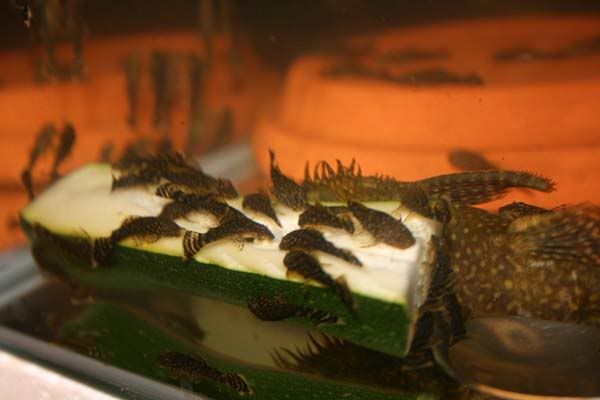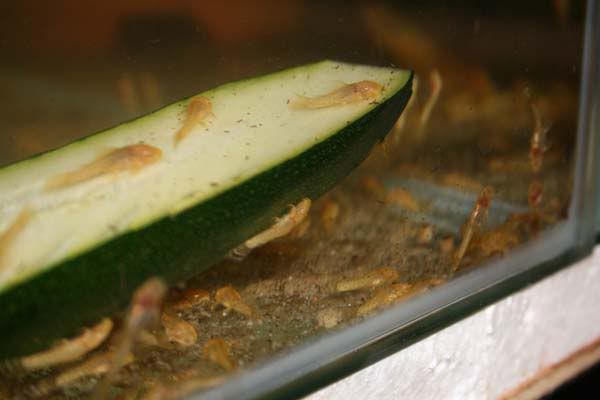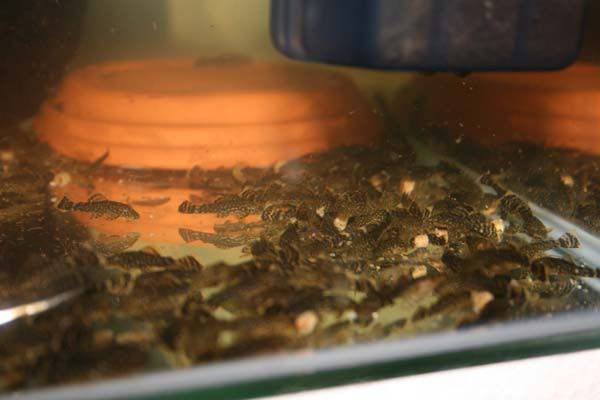Ancistrus cf. cirrhosus Fry Illness -- Help Please!
Posted: 26 Oct 2010, 17:58
I hope I am in the right place for this question.
My Ancistrus cf. cirrhosus started spawning in July. I do not intend to breed my fish; they did this on their own. I love my Bristlenoses, so I am thrilled, and moved the fry to a 10 gallon grow-out tank that I had been using as a quarantine tank, so it was cycled. The fish in the Q-tank were in there for R&R, not an illness. I moved 66 fry (about 10 days after they hatched), and another 10 or so stayed in the original tank with the parents. I have lost all the fry from the parent tank, except one, which is very healthy and 1.5 inches at this time. I have about 30 of the original clutch.
The second clutch appeared around the 25th of September with about 30 hatched fry. Those fry are about ½-¾ inch at this time. The original fry are between 1-1.5 inches.
The adult tank contains 3 males and 1 female grew, which grew up in a 20 gallon with 2 peaceful Skunk loaches, Black Neons and a 1.5 inch Golden Killie. The Bristlenoses and Skunks have lived together over 2 years, and the rest were added in the last 3 months after quarantine. There are no behavioral problems. None of the fish in the adult tank are affected at this time. The adults have been unaffected.
All fry except one are in the 10 gallon grow out tank. Some of the older fry are spread out among my other tanks to reduce the stress on a ten-gallon tank. Most of those fry are doing just fine. I have bogwood in all my tanks for the Bristlenoses and their fry to munch on. The wood has been in there for years, and it was boiled before it ever went into the water.
1. Water parameters
This week I had been gone for four days and the readings (BEFORE) were as follows:
a) Temperature range = 80
b) pH = 6.7
e)Ammonia = 0
Nitrate = 20
Nitrite = .25 (Surprise. I haven't had nitrite in my tanks for years.)
f) Water change frequency Normally 50 % every other day. Water conditioner = Prime
c) GH = Not available
d) KH = Not available
TDS Before: 321
After a 50 % water change today (AFTER):
a) Temperature range = 80
b) pH = 7.2 (Water in Fl is very basic, and my tank water is acidic.)
e) Ammonia = 0-.25 (API test gives a false positive when used with Prime.)
Nitrate = 10
Nitrite = 0
f) Water change frequency 50 % every other day. Water Conditioner = Prime
c) GH = Not available
d) KH = Not available
TDS Before: 321 (TDS of filtered tap water: 300)
TDS After: 317
2. Tank set up
a) Size = 10 gallons
b) Substrate = none
c) Filtration. = sponge filter and aquaclear filter for a 10 gallon.
d) Furnishings Plastic plants, coconut cave, piece of bog wood, smooth river rock
e) Other tank mates = 3, 1” Botia striata and 1, 1” Yoyo loach (in quarantine with no signs of ill health. The BN were ill before the loaches arrived.)
f) How long has it been set-up? July 2010. Cycled before that.
g) When was the last new fish added? 2 weeks ago (the loaches, but the BNs have had this problem about two months.)
h) Foods used and frequency? Washed and Blanched zucchini (2-3 X a week) and Hikari algae wafers several times a day when the previous food is gone. The loaches receive flake and 2 shrimp pellets every day and blood worms (once a week).
3. Symptoms / Problem description
White patch near the eyes appears, eventually turns into an abscess and the fish dies within about a week. Does not affect other fish, only the Bristlenose fry. Usually after they reach more than 1”.
Before I realized that there was problem, I distributed Bristlenose fry to other tanks to reduce their numbers in the 10-gallon grow out tank. Most of these do not develop the illness, but a couple do (I believe the problem stems from the tank water not being clean enough for the number of the fry). No other fish species develop this problem, and the adults do not have this problem.
4. Action taken (if any)
I tried a clean, cycled quarantine tank with nothing but clean water. The Bristlenoses died in a couple days. I tried with Maracyn 1, and they died within 5 days.
5. Medications used (if any)
Maracyn 1 – tried in a separate quarantine tank. The Bristlenoses I tried with the Maracyn all died by the fifth day.
I have a separate Q-tank I can use for treatment, if you have a treatment recommendation I should try for the fry that are showing symptoms. Also any suggestions to keep this problem at bay?
Right now I have no fish with symptoms, so I have no pictures. I will submit a picture when there is another problem.
Thank you so much for your help and advice.
My Ancistrus cf. cirrhosus started spawning in July. I do not intend to breed my fish; they did this on their own. I love my Bristlenoses, so I am thrilled, and moved the fry to a 10 gallon grow-out tank that I had been using as a quarantine tank, so it was cycled. The fish in the Q-tank were in there for R&R, not an illness. I moved 66 fry (about 10 days after they hatched), and another 10 or so stayed in the original tank with the parents. I have lost all the fry from the parent tank, except one, which is very healthy and 1.5 inches at this time. I have about 30 of the original clutch.
The second clutch appeared around the 25th of September with about 30 hatched fry. Those fry are about ½-¾ inch at this time. The original fry are between 1-1.5 inches.
The adult tank contains 3 males and 1 female grew, which grew up in a 20 gallon with 2 peaceful Skunk loaches, Black Neons and a 1.5 inch Golden Killie. The Bristlenoses and Skunks have lived together over 2 years, and the rest were added in the last 3 months after quarantine. There are no behavioral problems. None of the fish in the adult tank are affected at this time. The adults have been unaffected.
All fry except one are in the 10 gallon grow out tank. Some of the older fry are spread out among my other tanks to reduce the stress on a ten-gallon tank. Most of those fry are doing just fine. I have bogwood in all my tanks for the Bristlenoses and their fry to munch on. The wood has been in there for years, and it was boiled before it ever went into the water.
1. Water parameters
This week I had been gone for four days and the readings (BEFORE) were as follows:
a) Temperature range = 80
b) pH = 6.7
e)Ammonia = 0
Nitrate = 20
Nitrite = .25 (Surprise. I haven't had nitrite in my tanks for years.)
f) Water change frequency Normally 50 % every other day. Water conditioner = Prime
c) GH = Not available
d) KH = Not available
TDS Before: 321
After a 50 % water change today (AFTER):
a) Temperature range = 80
b) pH = 7.2 (Water in Fl is very basic, and my tank water is acidic.)
e) Ammonia = 0-.25 (API test gives a false positive when used with Prime.)
Nitrate = 10
Nitrite = 0
f) Water change frequency 50 % every other day. Water Conditioner = Prime
c) GH = Not available
d) KH = Not available
TDS Before: 321 (TDS of filtered tap water: 300)
TDS After: 317
2. Tank set up
a) Size = 10 gallons
b) Substrate = none
c) Filtration. = sponge filter and aquaclear filter for a 10 gallon.
d) Furnishings Plastic plants, coconut cave, piece of bog wood, smooth river rock
e) Other tank mates = 3, 1” Botia striata and 1, 1” Yoyo loach (in quarantine with no signs of ill health. The BN were ill before the loaches arrived.)
f) How long has it been set-up? July 2010. Cycled before that.
g) When was the last new fish added? 2 weeks ago (the loaches, but the BNs have had this problem about two months.)
h) Foods used and frequency? Washed and Blanched zucchini (2-3 X a week) and Hikari algae wafers several times a day when the previous food is gone. The loaches receive flake and 2 shrimp pellets every day and blood worms (once a week).
3. Symptoms / Problem description
White patch near the eyes appears, eventually turns into an abscess and the fish dies within about a week. Does not affect other fish, only the Bristlenose fry. Usually after they reach more than 1”.
Before I realized that there was problem, I distributed Bristlenose fry to other tanks to reduce their numbers in the 10-gallon grow out tank. Most of these do not develop the illness, but a couple do (I believe the problem stems from the tank water not being clean enough for the number of the fry). No other fish species develop this problem, and the adults do not have this problem.
4. Action taken (if any)
I tried a clean, cycled quarantine tank with nothing but clean water. The Bristlenoses died in a couple days. I tried with Maracyn 1, and they died within 5 days.
5. Medications used (if any)
Maracyn 1 – tried in a separate quarantine tank. The Bristlenoses I tried with the Maracyn all died by the fifth day.
I have a separate Q-tank I can use for treatment, if you have a treatment recommendation I should try for the fry that are showing symptoms. Also any suggestions to keep this problem at bay?
Right now I have no fish with symptoms, so I have no pictures. I will submit a picture when there is another problem.
Thank you so much for your help and advice.



